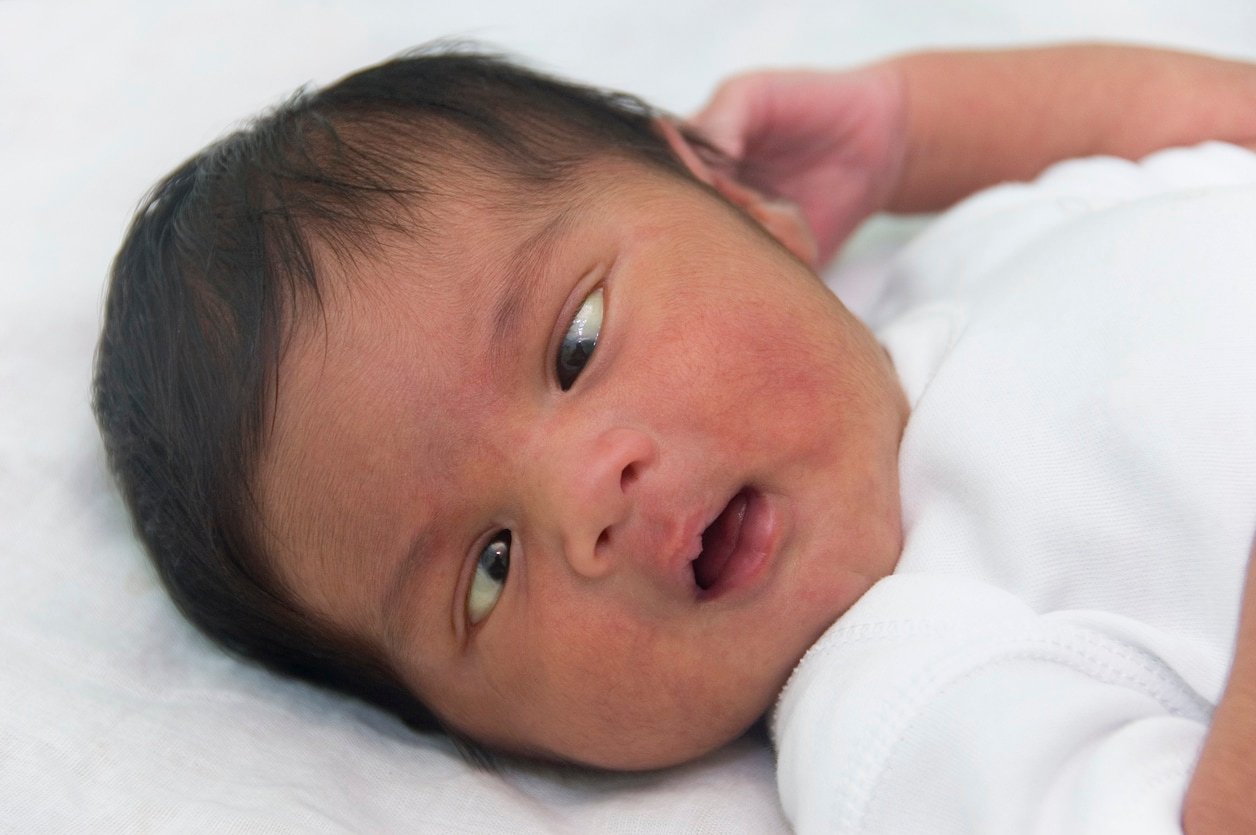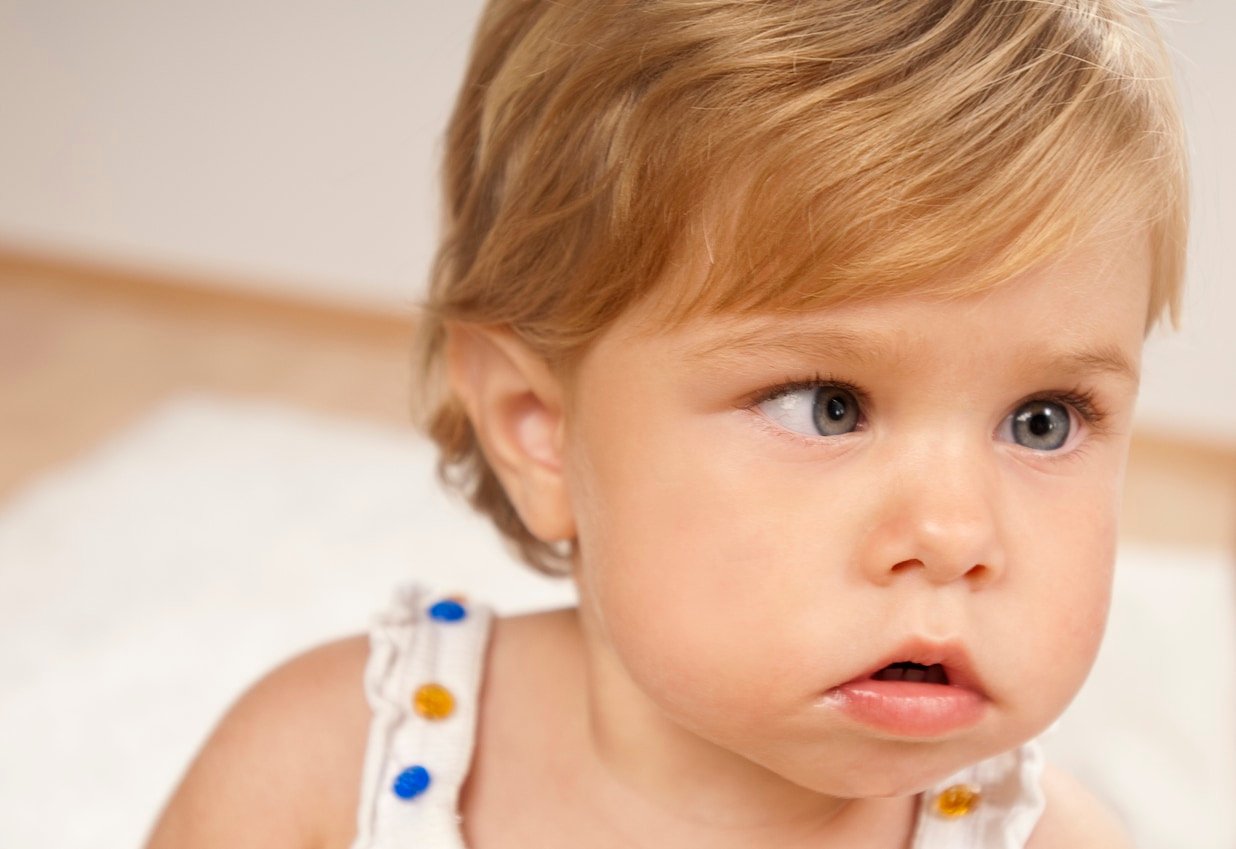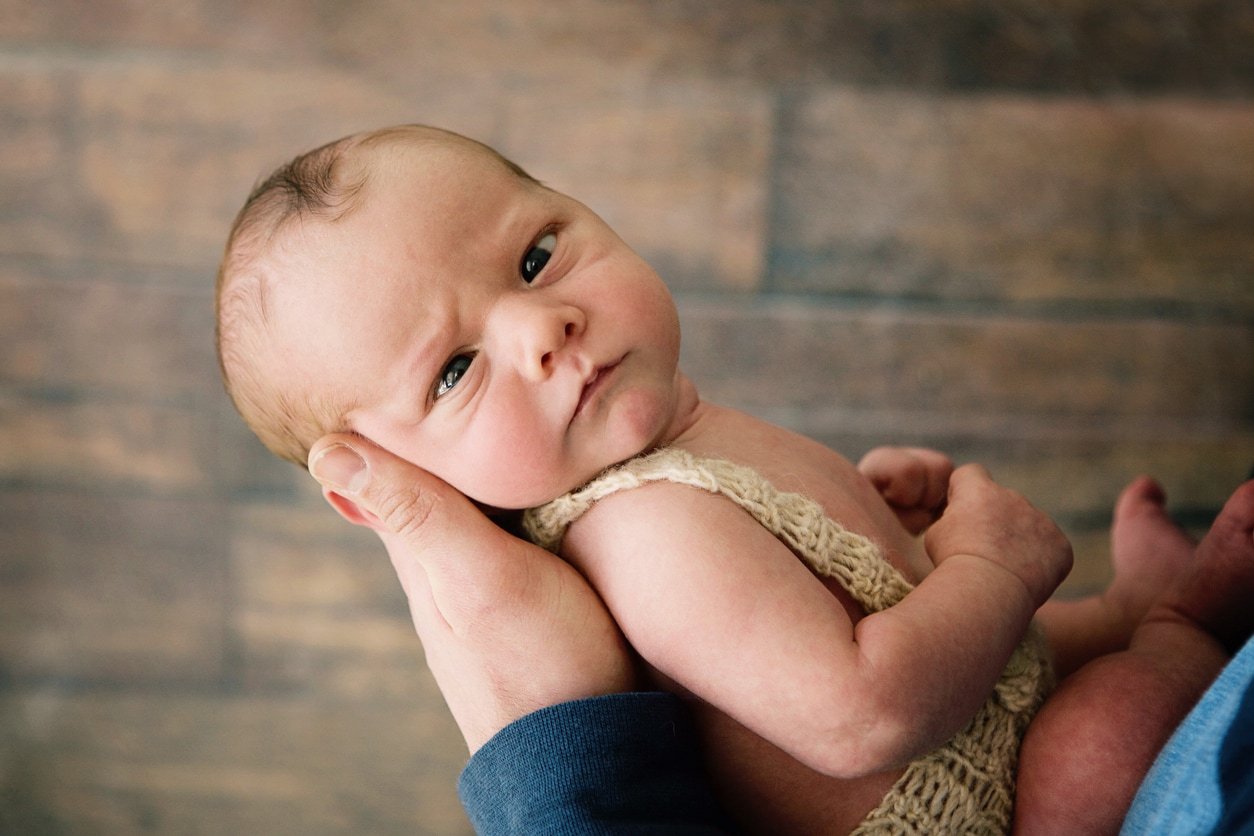
Newborns sleep most of the day away. In their short stints of alertness during the day, many parents simply want to stare into their new baby’s eyes. When observing your little one’s gaze, they may seem cross-eyed. Seeing a cross-eyed baby may worry you.
This may be normal depending on your baby’s age and the frequency you notice your newborn’s eyes crossed. If you are concerned about your newborn with crossed eyes, read on to learn whether your baby is genuinely cross-eyed, when they may grow out of their crossed eyes, and some causes and solutions for cross-eyed babies.
Is My Baby Cross-Eyed?
Babies can sometimes appear cross-eyed even when they are not. If their nose has a wide nasal bridge, this can give the illusion that one eye turns in more than the other. They can also seem cross-eyed if they have an extra fold of skin on the inner eyelid. This extra fold can cover more of the white of the eye, making it appear like your baby has asymmetrical eyes.1
If it is not the skin or the nose causing your baby to appear cross-eyed, your baby’s eyes may be misaligned or pointing in different directions. Your baby’s eyes may cross only occasionally, or they may always appear crossed. One or both eyes can point in, out, up, or down instead of straight ahead and parallel.2
There are two common causes of what parents describe as “crossed eyes.” The first is when the eyes are actually crossed, which is caused by a problem with the muscles that make the eyes move. The second is more commonly known as a “lazy eye.” A lazy eye can be caused by crossed eyes that are left untreated. It can also happen when the vision is poorer in one eye, so the brain only uses one eye to see, and the other eye becomes “lazy.”3-16
Is It Normal for My Baby To Be Cross-Eyed?
It can be normal for the eyes of very young babies to cross occasionally. Their eyes and ocular muscles have not had much practice in your dark womb, so they are uncoordinated. But if you are wondering when do babies’ eyes change, the answer is around four months. Your baby’s eyes should straighten out after 4 to 6 months. If they do not align around your baby’s half-birthday, your baby’s uneven eyes may not be normal.2
Cross-Eyed Baby at One Year

A pediatric ophthalmologist should evaluate babies who remain cross-eyed beyond 4 months. If they are still cross-eyed at 1 year of age, they may be diagnosed with strabismus. It is most often diagnosed between the ages of 1 and 4 but rarely can be diagnosed up until the age of 6.2
Your pediatrician should perform regular eye exams at your baby’s well-child visits. These are the best ways to detect any issues with crossed eyes. If the pediatrician notices crossed eyes during an exam of your baby, they may refer you to an eye doctor for further testing and treatment. It is essential to diagnose strabismus early to treat and resolve it.2
What Causes Cross-Eyes in Babies?
Here are some factors that could cause your little one to be cross-eyed:
Prematurity
Premature babies are at risk for retinopathy of prematurity, in which blood vessels grow abnormally in the eye.17 This condition has been shown to increase the risk of crossed eyes.18
Family History
People with parents or siblings with strabismus are more likely to have it themselves. This suggests a genetic link to weakened eye muscles.19,20
Medical Conditions
In some cases of a cross-eyed baby, it is not the eye muscles at fault but the nerves that control those muscles. If your child has suffered a stroke or head injury or has cerebral palsy or Down syndrome, their ocular nerves may struggle to make both eyes focus in alignment, causing crossed eyes. In addition, rare medical conditions may affect your child’s vision, which can lead to the appearance of being cross-eyed or having a “lazy eye” because one eye does not have the same vision as the other.20
Straining
If a child is vision-impaired with near- or far-sightedness, they may compensate by straining to see. This visual straining can cause the eyes to drift apart or misalign and become crossed over time.21
How To Naturally Fix Crossed Eyes in Babies

If you notice a cross-eyed baby, remember that this can be normal in the first four months of life. Their eye muscles may need to adjust to the outside world. In these first few months, there are some things you can do at home to strengthen crossed newborn eyes:
Support Visual Development
High-contrast images such as black-and-white cards are easier for your baby to focus on. Expose them to many images and environments.22
Practice Tracking
Hold an image or toy 8 to 10 inches from your infant’s face; this is the optimal distance for seeing until 4 months old. Slowly move the object from side to side, encouraging your cross-eyed baby to maintain their focus on it. You can also encourage the tracking of objects by moving or turning your baby slowly around a room. This allows them to practice tracking objects and switching focus.22
Maintain Balance
Alternate the side that you hold your baby to feed, and switch up the side of the crib on which you lay them down to sleep. This allows both eyes to strengthen evenly as your baby looks out and practices seeing equally out of both eyes and turning their head in each direction.22
When Do Babies’ Eyes Stop Crossing?
While it may be tempting to wait out your baby’s crossed eyes to see if they improve on their own, this will likely make the crossed eyes worse, not better. Children are unlikely to outgrow cross-eyes. As the stronger eye becomes more dominant, the crossed eye can become more prominent and “lazy.” 20
If your baby’s crossed eyes persist beyond four months, mention it to their primary care provider. You may be eager to fix your baby’s crossed eyes, but it is often best to leave this to professionals.
Treatment for a Cross-Eyed Baby
In the most common diagnosis for crossed eyes (strabismus), the treatment is to strengthen the weaker eye. The best way to do this is to suppress vision in the stronger eye, thereby encouraging the child’s brain to work to focus with the weaker eye. You can achieve this using glasses, an eye patch, or glasses. Very rarely, crossed eyes in babies may need surgical repair.2
Often, a young cross-eyed baby is nothing to worry about and will resolve independently. Encourage your baby to focus, turn their head in each direction, and see with both eyes. If your baby’s crossed eyes persist or worsen, or you are concerned, your pediatrician should be able to help you determine the next steps. It is good to pay attention to your baby’s eye alignment, as early discovery and treatment of crossed eyes provide the best outlook for their alignment and vision.2
from Baby Chick https://ift.tt/rEBNRKd
via IFTTT



0 Comments
Please ,
Don't enter span link ...